A number of people have complained, myself included, on the need to adjust the pin gap on Fritschi’s Vipec. It is easy to think something is wrong with Vipec because it has to be adjusted. Keep in mind it operates on a different mechanism for release and it doesn’t tolerate the variance that, based on results, exists among tech inserts.
Considering the problems Garmont and Salomon went through with their tech inserts it’s not hard to believe there would be differences in their width. Vipec specs indicate the ability to adjust 1.2mm, implying that’s the range of possible insert widths, or pin-gap when the pins are closed. One-point-two millimeters isn’t that much, is it?
As it turns out, maybe it is. When dimensions are small, and tech toes are petite, tolerances need to be even tighter. Fritschi says the variation isn’t just between makers, it appears to happen even from within the same brand. Yeah, even the Dynafit brand.
Dimensional Details
There is plenty of evidence to prove inconsistent insert dimensions. Consider the plight of the rare but not unheard of guy or gal who does blow out of their Dynafits more often than they should. Most times this is due to dirt or ice in the inserts, but either way, it demonstrates how sensitive the system is to the pin gap.
Back in 2010 Lou Dawson published some data that G3 recorded to show the difference between their Onyx toe and Dynafit’s toe. It shows that Onyx has more force applied to the pins and needs to spread wider before it will tip open. This is due, not to a difference in spring values, but in the pivot location of the arms holding the pins. Actually, Onyx is designed to never cam open, but its new brother, Ion does.In the case of Dynafit and the litter of knock offs, the pressure increases for the first few millimeters of spread, until they are about 59 mm apart. Wider than that and the force declines as the jaws open up, but doesn’t cross the threshold to open until they are 61 mm apart. When the pins are seated, history proves there is adequate force to hold you in — at least for feet on the ground style skiing. What should be obvious is the wider the gap when the pins are seated, the less distance they must travel before the force holding them in declines.
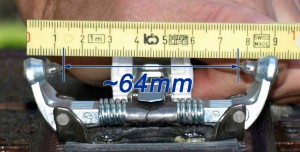
Tipping point for Dynafit’s Vertical toe. Same dimensions for the Radical, but the Power Towers affect the results.
Who Cares?
Being that the difference between staying in and pre-releasing is sometimes only a millimeter, perhaps the problem isn’t your binding, it’s the insert, even if the solution is to get a new binding. This whole predicament, premature release with 2-pin tech bindings, is why there are so many exciting new tech bindings being developed.
Dynafit already addressed this issue to a small degree with the Power-Towers in the Radical toe. Primarily added as an aid to clicking in, they help block excessive movement. Fritz Barthel’s better solution is to allow the boot to rotate at the heel with a toe that rotates a few degrees, unobstructed. It delays the onset of force on the toes, yielding lateral movement in the 13mm range. Simple, ingenious, and effective.G3 addressed this issue years ago with the Onyx. The main difference was the geometry of the pin arms/jaws. A higher fulcrum point develops higher forces to overcome in spreading the jaws. This design feature continues with Ion and the development of a fast, easy step in method.
Vipec allows lateral release at the toe by holding the pins tight while letting the boot rotate on a carriage. When it swings wide enough, the jaws open up. It allows a pretty wide displacement before letting go, 11 mm.
Solution?
The good news is this is a concern for a minority of AT skiers. If you’re in that minority and are actually experiencing premature release the solution is simple. If you love your boots, get a new binding, one that allows more elasticity. If you don’t like your boots anyway, replace both. Likewise if you’re new to the game, and not ready to believe, get a new binding. Otherwise, if you have an older generation tech toe you need to make sure the inserts are clean, or shut up, man up and lock ’em out. 😉
© 2014
Related Post
Dynafit VS Onyx Jaw Pressure on WildSnow

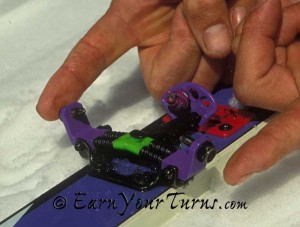
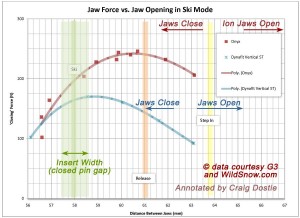
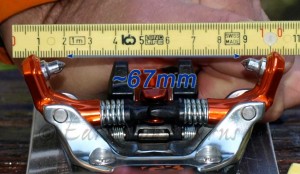
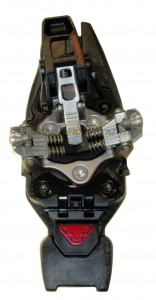
Recent Comments